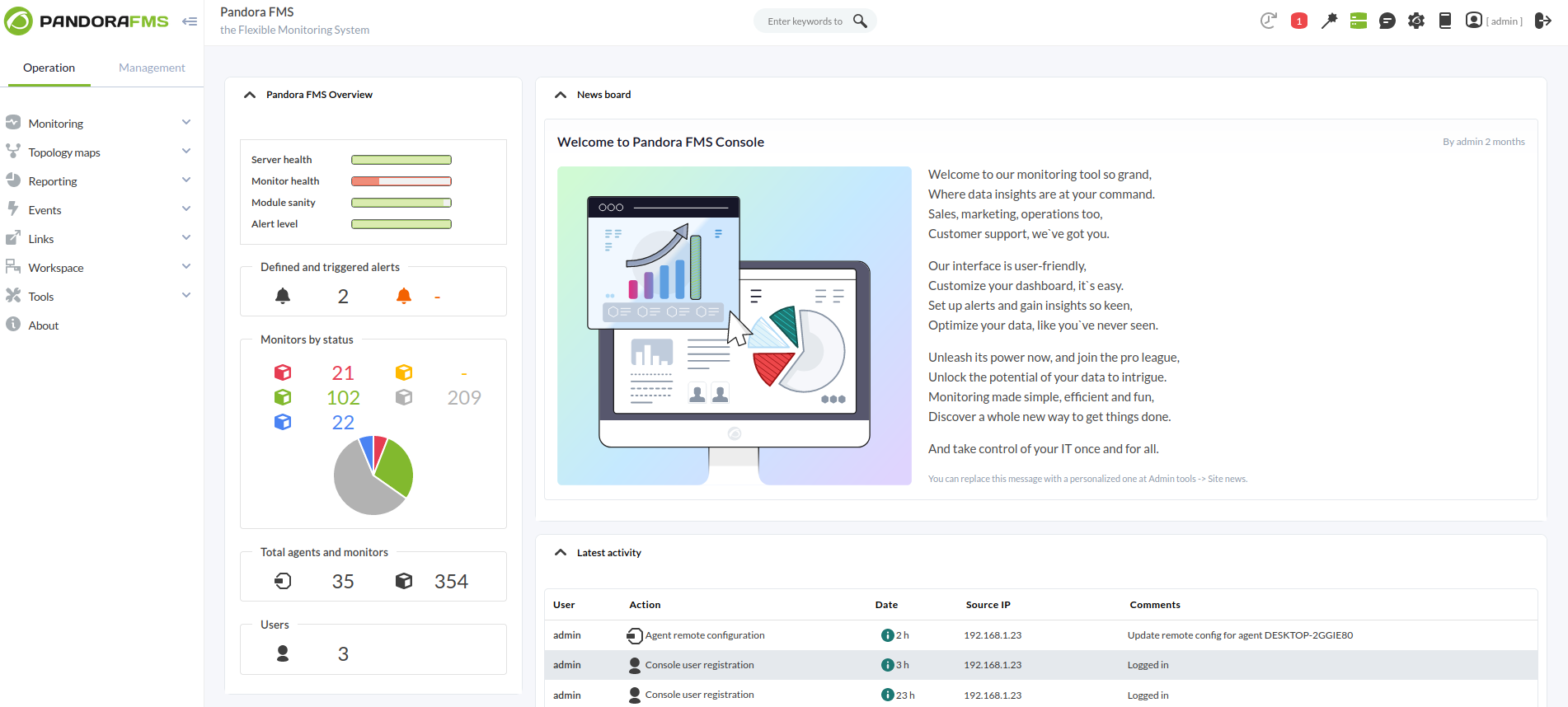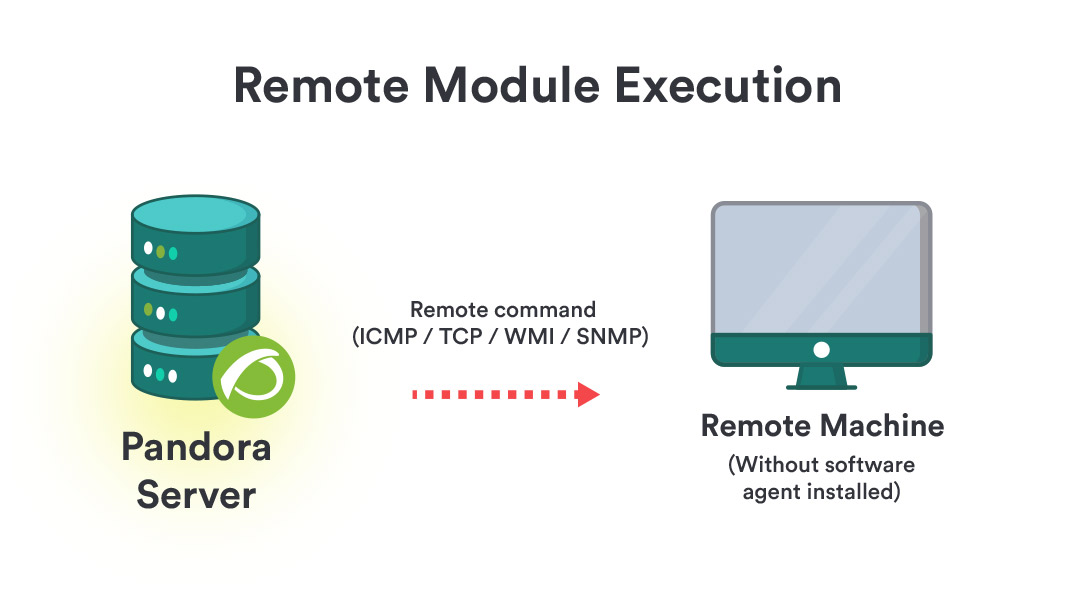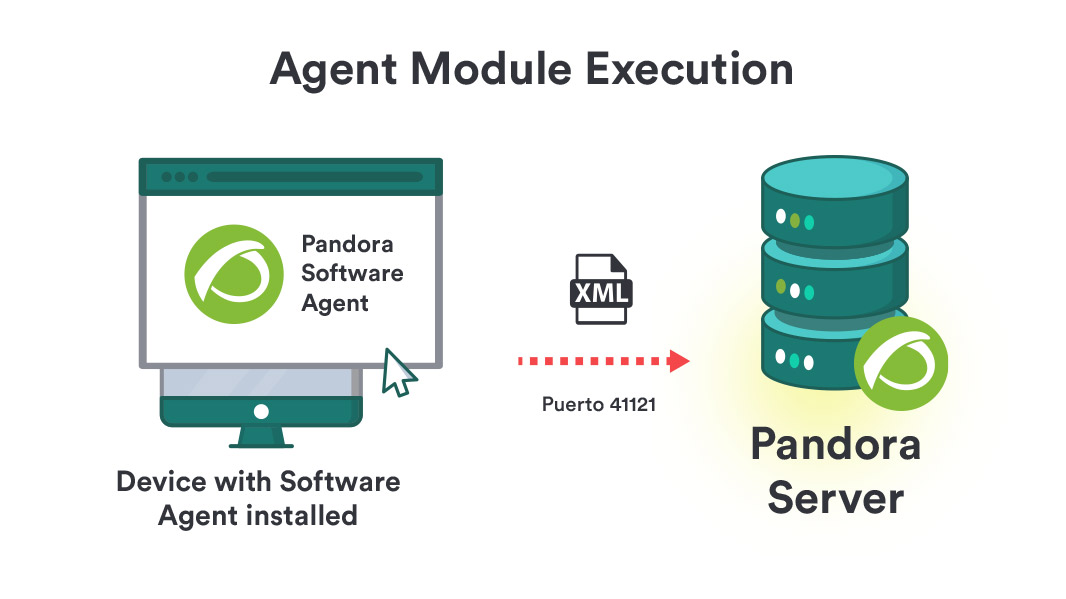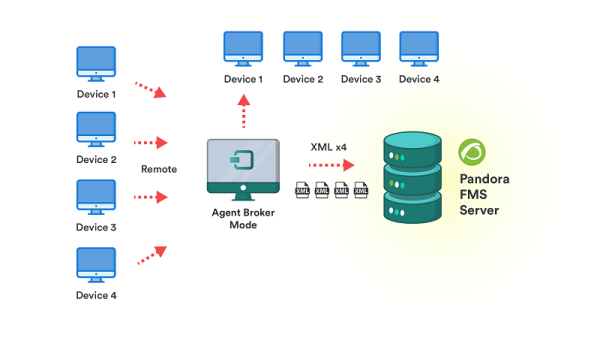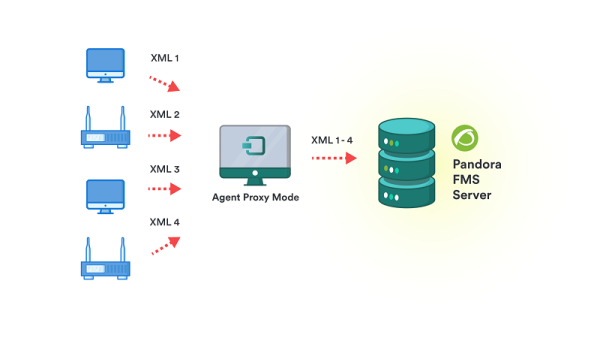2. Basic Architecture
Pandora FMS servers
Servers are integrated into a single application, usually called Pandora Server, which is a multithreaded application that executes different instances or specialized Pandora FMS servers at the same time. These are the elements in charge of performing the existing checks, as they verify and change their status according to the results obtained. They are also in charge of triggering the alerts that are established to control data status.
Pandora FMS automatically manages the status of each server, its load level and other parameters. Users can monitor the status of each server through the server status section of the Web Console.
The basic servers are the following ones:
Open
Data server: It is in charge of processing the information sent by software agents (in XML format), the server processes it and stores the result in the database. It is also in charge of generating alerts and events according to this data. To enable the server, it is necessary to configure the dataserver 1 line in the /etc/pandora/pandora_server.conf file.
Network server: This server executes remote monitoring tasks through the network, it could be ICMP checks, TCP requests and SNMP requests. The server and the remote machines must have communication to execute these checks. To enable the server, it is necessary to configure the networkserver 1 line in the /etc/pandora/pandora_server.conf file.
Discovery server: It allows to explore networks to detect computers and apply monitoring templates to them quickly. It also allows quick deployment of specific monitoring of databases, cloud systems and virtual environments. It includes the necessary tools to discover or import devices and equipment in the network. To enable the server, it is necessary to configure the discoveryserver 1 line in the /etc/pandora/pandora_server.conf file.
Plugin server: It allows complex remote monitoring, since it runs complex checks from Pandora FMS server by means of custom scripts. It is a centralized process, integrated into Pandora FMS interface. This server allows advanced users to define their own checks, developed by themselves, and integrate them into the application so that they can be used easily from Pandora FMS. To enable the server it is necessary to configure the pluginserver 1 line in the file /etc/pandora/pandora_server.conf.
Prediction server: This server predicts numerical values using statistics and modules with real data as source, allows to detect anomalies out of the usual trends and creates new values from prediction statistics, which can be used as baselines. It also allows to create new values by arithmetic operations with the values of existing modules (synthetic modules). To enable the server, it is necessary to configure the predictionserver 1 line in the /etc/pandora/pandora_server.conf file.
WMI server: This server allows remote monitoring of Windows systems using the WMI protocol. This is done by executing WMI sentences, remote sentences supported by any Windows system with WMI enabled that allow to obtain Hardware and Software information. To enable the server, it is necessary to configure the wmiserver 1 line in the file /etc/pandora/pandora_server.conf.
Inventory server: The inventory server obtains and displays system inventory information: installed software, hardware item model, hard disks, services running on the system, etc. This information can be obtained both remotely (from Pandora server) and locally (through software agents). It does it by using the same monitoring agents or remotely, with extensions developed by the user, both for Windows and Unix. To enable the server it is necessary to configure the inventoryserver 1 line in the /etc/pandora/pandora_server.conf file.
Web server: It is used to perform full web checks, from user identification process, to parameter transfer through a form, content checking, menu navigation, etc. It allows performing availability checks (working or not working) and obtaining latency times (in seconds) of the complete browsing experience, including resources associated to the page (images, full texts, etc). It is based on Goliath (Web audit server), which is OpenSource. To enable the server, it is necessary to configure the webserver 1 line in the /etc/pandora/pandora_server.conf file.
SNMP Traps Console: This server uses the standard trap collection system daemon, snmptrapd. This daemon receives SNMP traps and Pandora FMS SNMP console processes and stores them in the database. It is also in charge of launching the alerts associated to SNMP traps were defined. To enable the server, configure the snmpconsole 1 line in the /etc/pandora/pandora_server.conf file.
Enterprise
Enterprise ICMP server: This server multiplies the efficiency of ICMP checks. It uses the nmap binary installed with Pandora FMS Enterprise version. It uses nmap version 5.5. or higher. To enable the server, it is necessary to configure the inventoryserver 1 line in the /etc/pandora/pandora_server.conf file.
Enterprise SNMP server: This server increases the efficiency of SNMP checks. It uses the braa binary installed with the Enterprise version of Pandora FMS. The braa binary, used by the enterprise SNMP server is located at /usr/bin/braa by default. It is compatible with SNMP V1 and v2. SNMP v3 checks will be performed by the network server. It requires for the network server to operate simultaneously, to translate the OIDs. To enable the server, it is necessary to configure the snmpserver 1 line in the /etc/pandora/pandora_server.conf file.
Syslog server: This component allows Pandora FMS to analyze the syslog of the machine where it is located, analyzing its content and storing the references in the corresponding ElasticSearch server. The main advantage of the syslog server is to complement log merging. With the support of the exporting features of the syslog server of Linux® and Unix® environments, it allows log consultation regardless of the source, searching in a single common point (Pandora FMS console log viewer). To enable the server, it is necessary to configure the syslogserver 1 line in the /etc/pandora/pandora_server.conf file.
You may set the number of threads that the processes will use in the instance where Pandora FMS is installed for each server.
Pandora FMS web console
It is the user interface of Pandora FMS, it allows to control Agent status, see statistical information, generate graphs and data tables. It is also able to generate reports and centrally define new agents, modules, alerts and create other users and profiles.
Pandora FMS database
Pandora FMS uses a MySQL database in which all the information received in real time is stored, normalizing all the data from the different sources (server, agents...).
Currently Pandora FMS only supports MySQL, MariaDB and Percona.
Agents
In Pandora FMS there are two types of agents and they can run remote and local modules:
- Remote Agent: This type of agent is an organizational element created in Pandora FMS Web Console, it usually contains remote modules that are run by those servers that obtain information remotely, such as the network server.
- Software Agent: It is a software installed on the equipment to be monitored locally, retrieving information from the computer itself, it allows monitoring machine resources (CPU, RAM, disks...) and the installed applications (MySQL, Apache, JBoss). All the information collected by software agents is sent to the server in XML format through the Tentacle protocol (SSH or FTP is allowed) at a predetermined interval of 5 minutes (300 seconds).
Overall, server and computer monitoring will be carried out with Software Agents while network equipment monitoring will be done remotely without installing any software.
Topologies, overviews and monitoring modules
Ideally all monitored computers must be connected to Pandora FMS server, but sometimes you will find cases in which you do not have total communication between the different elements you wish to monitor, se we are going to mention different situations you may face and how to solve them.
Accessible networks
- Accessible network for centralized remote monitoring: Pandora FMS server has communication with all network machines.
- Accessible network for Agent-based monitoring: Software agents are those that have communication with Pandora FMS server.
Hard-to-access networks
- Remote network not reachable by Pandora FMS remote checks: It uses the broker agent mode.
- Software Agents that do not have access to Pandora FMS server: In this case it uses the proxy feature of Software Agents or a Satellite server as a proxy of software agents.
-
Different networks to monitor remotely with the server: You may use the Satellite Server or several different Pandora FMS servers connected to the same database.
Did you not achieve the expected results? Go to help or support sections.


